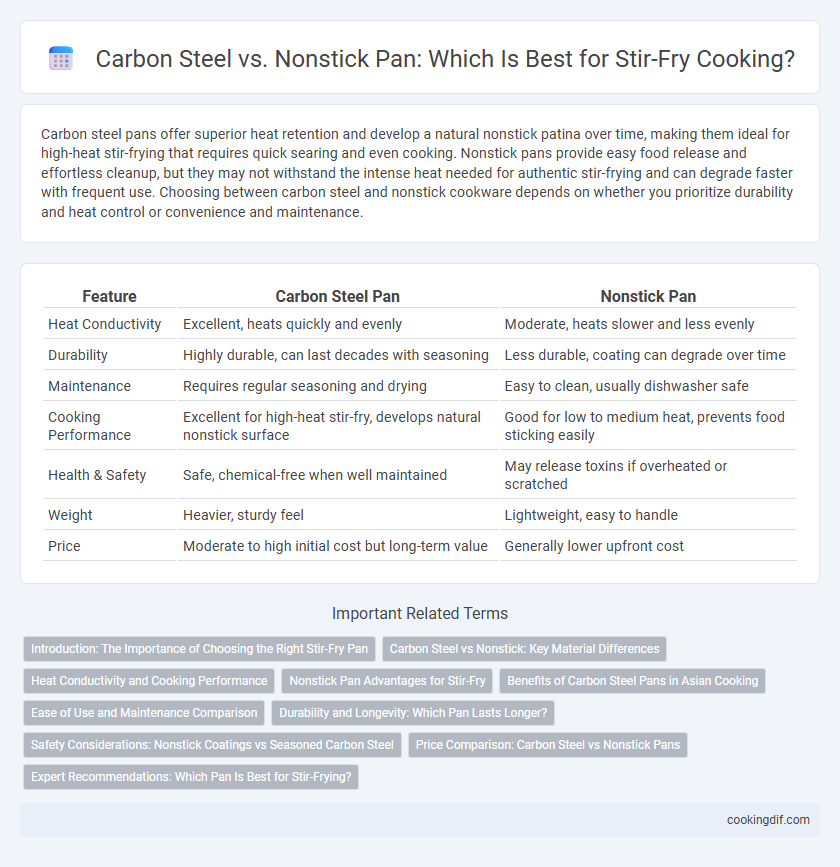Carbon steel pans offer superior heat retention and develop a natural nonstick patina over time, making them ideal for high-heat stir-frying that requires quick searing and even cooking. Nonstick pans provide easy food release and effortless cleanup, but they may not withstand the intense heat needed for authentic stir-frying and can degrade faster with frequent use. Choosing between carbon steel and nonstick cookware depends on whether you prioritize durability and heat control or convenience and maintenance.
Table of Comparison
| Feature | Carbon Steel Pan | Nonstick Pan |
|---|---|---|
| Heat Conductivity | Excellent, heats quickly and evenly | Moderate, heats slower and less evenly |
| Durability | Highly durable, can last decades with seasoning | Less durable, coating can degrade over time |
| Maintenance | Requires regular seasoning and drying | Easy to clean, usually dishwasher safe |
| Cooking Performance | Excellent for high-heat stir-fry, develops natural nonstick surface | Good for low to medium heat, prevents food sticking easily |
| Health & Safety | Safe, chemical-free when well maintained | May release toxins if overheated or scratched |
| Weight | Heavier, sturdy feel | Lightweight, easy to handle |
| Price | Moderate to high initial cost but long-term value | Generally lower upfront cost |
Introduction: The Importance of Choosing the Right Stir-Fry Pan
Choosing the right stir-fry pan significantly affects cooking performance and flavor development, with carbon steel and nonstick pans offering distinct advantages. Carbon steel pans provide superior heat retention and high-temperature tolerance, ideal for achieving the characteristic sear and wok hei in stir-frying. Nonstick pans excel in easy food release and low-oil cooking but may lack the intense heat capacity needed for authentic stir-fry techniques.
Carbon Steel vs Nonstick: Key Material Differences
Carbon steel pans offer superior heat conductivity and a naturally nonstick surface that improves with seasoning, making them ideal for high-heat stir-frying and achieving a perfect sear. Nonstick pans feature a coated surface that prevents food from sticking without seasoning, providing easy cleanup but often falling short in withstanding the intense heat and rapid temperature changes typical in stir-fry cooking. The durability and heat tolerance of carbon steel make it a preferred choice for professional stir-fry techniques, while nonstick pans cater to convenience and low-fat cooking styles.
Heat Conductivity and Cooking Performance
Carbon steel pans offer superior heat conductivity, allowing for rapid, even heating essential for high-heat stir-frying techniques. Their ability to reach and maintain high temperatures ensures optimal searing and caramelization, enhancing the flavor and texture of stir-fry dishes. Nonstick pans, while easier to clean and requiring less oil, generally have lower heat tolerance and uneven heat distribution, which can compromise stir-fry performance and result in less desirable browning.
Nonstick Pan Advantages for Stir-Fry
Nonstick pans offer superior food release, preventing delicate stir-fry ingredients from sticking and breaking apart during cooking. Their easy cleanup and reduced need for oil make them ideal for health-conscious cooks aiming to prepare quick, low-fat meals. Additionally, nonstick surfaces distribute heat evenly, ensuring consistent cooking results without the risk of burnt or unevenly cooked stir-fry dishes.
Benefits of Carbon Steel Pans in Asian Cooking
Carbon steel pans offer superior heat retention and quick responsiveness, essential for achieving the high temperatures required in authentic Asian stir-fry techniques. Their natural nonstick surface develops over time through seasoning, enabling better browning and flavor development without the use of excessive oil. Unlike nonstick pans, carbon steel withstands intense heat and metal utensils, making it ideal for versatile and long-lasting stir-fry cookware.
Ease of Use and Maintenance Comparison
Carbon steel pans heat quickly and develop a natural nonstick patina with seasoning, making them ideal for high-heat stir-frying but requiring regular maintenance such as drying immediately and occasional re-oiling to prevent rust. Nonstick pans provide easy food release and simple cleaning, suitable for low to medium heat, but their coatings can degrade over time and may limit the use of metal utensils. Choosing between carbon steel and nonstick depends on balancing the desire for a durable, high-performance pan with the convenience of effortless cleaning and minimal upkeep.
Durability and Longevity: Which Pan Lasts Longer?
Carbon steel pans offer superior durability and longevity compared to nonstick pans, as their robust material withstands high heat and frequent use without significant wear. Nonstick pans tend to degrade faster due to coating scratches and heat damage, reducing their lifespan significantly. Ultimately, carbon steel cookware can last for decades with proper seasoning and maintenance, while nonstick pans often require replacement within a few years.
Safety Considerations: Nonstick Coatings vs Seasoned Carbon Steel
Nonstick pans offer convenience with easy food release but may release harmful fumes if overheated above 500degF, raising safety concerns. Seasoned carbon steel pans develop a natural, non-toxic patina that prevents sticking and withstands high temperatures without hazardous coatings. Choosing carbon steel reduces exposure to potentially toxic chemicals, providing a safer cookware option for high-heat stir-frying.
Price Comparison: Carbon Steel vs Nonstick Pans
Carbon steel pans for stir-fry are generally more affordable than high-quality nonstick pans, offering durable performance at a lower upfront cost. While nonstick pans range from $30 to $150 depending on brand and coating quality, carbon steel options typically fall between $20 and $60, providing budget-friendly durability. The cost-effectiveness of carbon steel increases with longevity, as these pans develop a natural nonstick seasoning over time, reducing the need for frequent replacement.
Expert Recommendations: Which Pan Is Best for Stir-Frying?
Expert recommendations for stir-fry cookware emphasize carbon steel pans for superior heat retention and quick temperature response, essential for achieving authentic wok hei flavor. Nonstick pans, while easier to clean and suitable for low-fat cooking, often lack the high heat tolerance required for effective stir-frying. Carbon steel's natural seasoning enhances non-stick properties over time, making it the preferred choice among professional chefs for optimal stir-fry performance.
Carbon steel vs Nonstick pan for stir-fry cookware Infographic

 cookingdif.com
cookingdif.com